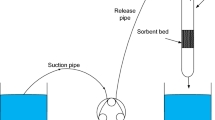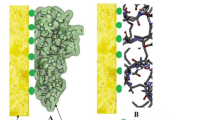Abstract
A mixed microbial culture was immobilized by entrapment into silica gel (SG) and entrapment/ adsorption on polyurethane foam (PU) and ceramic foam. The phenol degradation performance of the SG biocatalyst was studied in a packed-bed reactor (PBR), packed-bed reactor with ceramic foam (PBRC) and fluidized-bed reactor (FBR). In continuous experiments the maximum degradation rate of phenol (q s max) decreased in the order: PBRC (598 mg l−1 h−1) > PBR (PU, 471 mg l−1 h−1) > PBR (SG, 394 mg l−1 h−1) > FBR (PU, 161 mg l−1 h−1) > FBR (SG, 91 mg l−1 h−1). The long-term use of the SG biocatalyst in continuous phenol degradation resulted in the formation of a 100–200 μm thick layer with a high cell density on the surface of the gel particles. The abrasion of the surface layer in the FBR contributed to the poor degradation performance of this reactor configuration. Coating the ceramic foam with a layer of cells immobilized in colloidal SiO2 enhanced the phenol degradation efficiency during the first 3 days of the PBRC operation, in comparison with untreated ceramic packing.
Similar content being viewed by others
Author information
Authors and Affiliations
Additional information
Received: 2 December 1999 / Revision received: 2 February 2000 / Accepted: 4 February 2000
Rights and permissions
About this article
Cite this article
Brányik, T., Kuncová, G. & Páca, J. The use of silica gel prepared by sol-gel method and polyurethane foam as microbial carriers in the continuous degradation of phenol. Appl Microbiol Biotechnol 54, 168–172 (2000). https://doi.org/10.1007/s002530000366
Issue Date:
DOI: https://doi.org/10.1007/s002530000366




